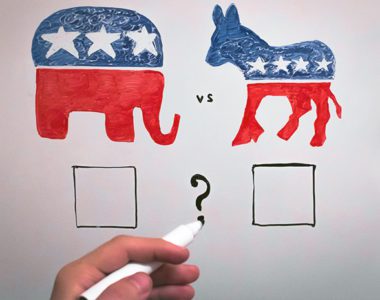 There are a number of challenges to teaching news literacy today, not least of which is that news literacy inherently involves reading, well, the news. As we all know, our current news environment is highly polarizing, which is one of the very reasons it is important to teach news literacy. Consequently, teaching about bias and misinformation inherently requires bringing politics into the classroom.
There are a number of challenges to teaching news literacy today, not least of which is that news literacy inherently involves reading, well, the news. As we all know, our current news environment is highly polarizing, which is one of the very reasons it is important to teach news literacy. Consequently, teaching about bias and misinformation inherently requires bringing politics into the classroom.
Many educators are hesitant to bring in politics for three main reasons:
- The topics themselves require educators to have wide-ranging political knowledge
- Educators are concerned about accusations of bias themselves from students, parents, and administrators
- Some of the topics require discussions of highly sensitive and personal issues
Each of these concerns is understandable; talking about the news can mean talking about abortion, guns, race, immigration, the LGBT community, coronavirus, and Trump. That is a lot of complex and polarizing ground to cover.
Regarding the first concern—needing to have political knowledge yourself—there are great resources for preparing yourself to meet this challenge, including Infobase’s Issues & Controversies and World News Digest databases. You can get yourself up to speed on nearly any major contemporary political issue with such resources, so I won’t dwell on this subject. This blog post focuses on the second and third concerns listed above.
Maintaining Fairness and Mitigating Your Own Bias
Educators rightfully strive to be fair and even “neutral” about their own political beliefs. Altruistically, most teachers wish to encourage students’ own critical-thinking skills and avoid making students feel unwelcome for their political beliefs.
But further, out of a sense of self-preservation, teachers wish to avoid displaying political bias because they do not want to draw the ire of students, parents, or administrators. No one wants to be the subject of a complaint that they are “indoctrinating” anyone’s children.
Over the years, I have heard from many educators who use the Media Bias Chart® in their classrooms because they view it as fair, impartial, and a great starting point for media literacy discussions, and who are surprised to hear pushback from parents about it. Partisan parents often have many thoughts on where their favorite news sources should be placed on the chart.
I have found, with most audiences, a best practice to using the Media Bias Chart is to start with a blank version of it to explain the overall concepts of more and less reliable and biased sources. Then, I explain that Ad Fontes Media uses a team of politically balanced analysts to generate ratings and place sources on the chart, but that students should view our ratings as a guidepost, not as some absolute truth they must accept. I explain that they may disagree with certain news source ratings based on their own experiences.
To avoid accusations of bias, I always recommend that any teaching using the Media Bias Chart include an exercise where students make their own determinations about how biased and reliable a given news article or source is.
Such exercises in which they make their own decisions is important for student buy-in about basic news literacy concepts. Even if students disagree on where a news article or news source would land, they can all agree that some sources are relatively better, worse, more and less right, and more and less left than others.
If students, parents, and administrators understand that you are not teaching that the Media Bias Chart ratings comprise a set of truths that must be accepted uncritically, and that conversely, you are teaching students to critically evaluate news sources themselves, you can avoid confrontations and foster agreement.
Discussing Controversial Political Topics
Our news landscape can be extremely polarizing, and the very nature of extreme polarization is that it is based on denying the experience of others and sometimes even dehumanizing them. The worst kinds of biased news content often use gross generalizations about “the other side.” These stories make straw man arguments against political opponents, call them names, and even say that they are evil or inhuman. They go far past the bounds of civil political discourse—the kind where people justify their different beliefs based on facts and reason.
 As a result, the arguments contained in such polarizing news sources can sometimes be hurtful for some students to read, and if other students adopt those arguments, they can end up saying hurtful things to their classmates.
As a result, the arguments contained in such polarizing news sources can sometimes be hurtful for some students to read, and if other students adopt those arguments, they can end up saying hurtful things to their classmates.
It is important to start any difficult topic by reminding students about the possibility that their classmates may have personal experience with the issue, and that it is not just political to them. In other words, polarizing news intentionally dehumanizes others—you can combat that by intentionally humanizing people on both sides of an issue.
You can and should bring up specific (but fictional) examples that might give someone a particular perspective on an issue. For example, if you are going to talk about immigration, you should bring up the fact that some students in the room may be immigrants or the children of immigrants themselves.
If you are going to talk about unequal use of police force against people of color, you should bring up the fact that some students may have parents or relatives who are police officers, and that other students may have felt endangered themselves during a police encounter. The simple fact of reminding students of the real-life experiences of their classmates can help them avoid the urge to adopt simplistic generalizations and hurtful arguments.
One key concept to remember about judging news stories is that you and your students do not have a responsibility to be NEUTRAL—you just have a responsibility to be FAIR. To understand the difference, think of what a judge is asked to do. A judge listens to the facts and arguments of both sides and has a duty to be as fair as possible, but at the end of the case, the judge doesn’t remain neutral and say, “Well, both sides have a point.” The judge determines which side had a better argument. You and your students can do the same regarding your positions on a political topic. This concept of “fair but not neutral” allows room for listening to different arguments and allowing room for different judgments.
 Although discussing politics in class can be intimidating, it is often highly engaging and ultimately rewarding. Sticking to the principles outlined herein can help ensure such discussions stay civil and productive. In order to teach news literacy, we must face polarizing topics head-on.
Although discussing politics in class can be intimidating, it is often highly engaging and ultimately rewarding. Sticking to the principles outlined herein can help ensure such discussions stay civil and productive. In order to teach news literacy, we must face polarizing topics head-on.
See also:
How to Evaluate Any News Content for Reliability and Bias, the first chapter in this series.
The next chapters in this series:
- Teaching About Conspiracy Theories and Memes: The Internet’s Most Outlandish and Compelling Content
- How to Incorporate News Literacy into Any Curriculum and Be Confident in Evaluating News Content from Any Source
NEWS LITERACY WORKSHOP: Step-by-Step Strategies for Educating Your Students
Join expert Vanessa Otero for a free, 4-part SEL workshop!
Information Literacy Products and Content for All Learners: Instant Trial Access
Resources to support news literacy, digital citizenship, election coverage, and more
Why It Is Challenging to Teach News Literacy in Today’s World, and How to Do So Effectively Anyway


